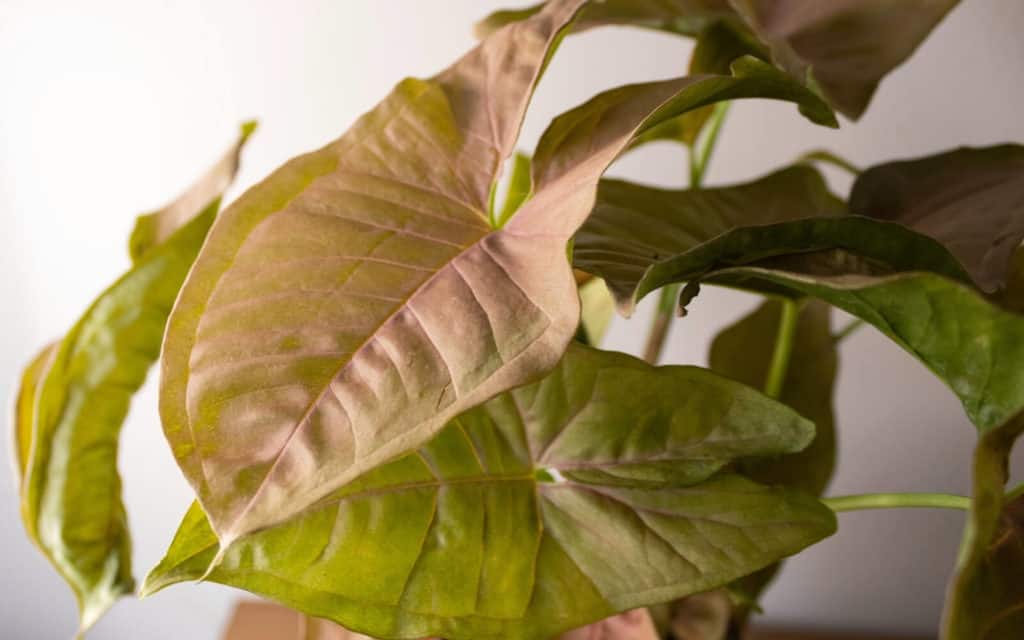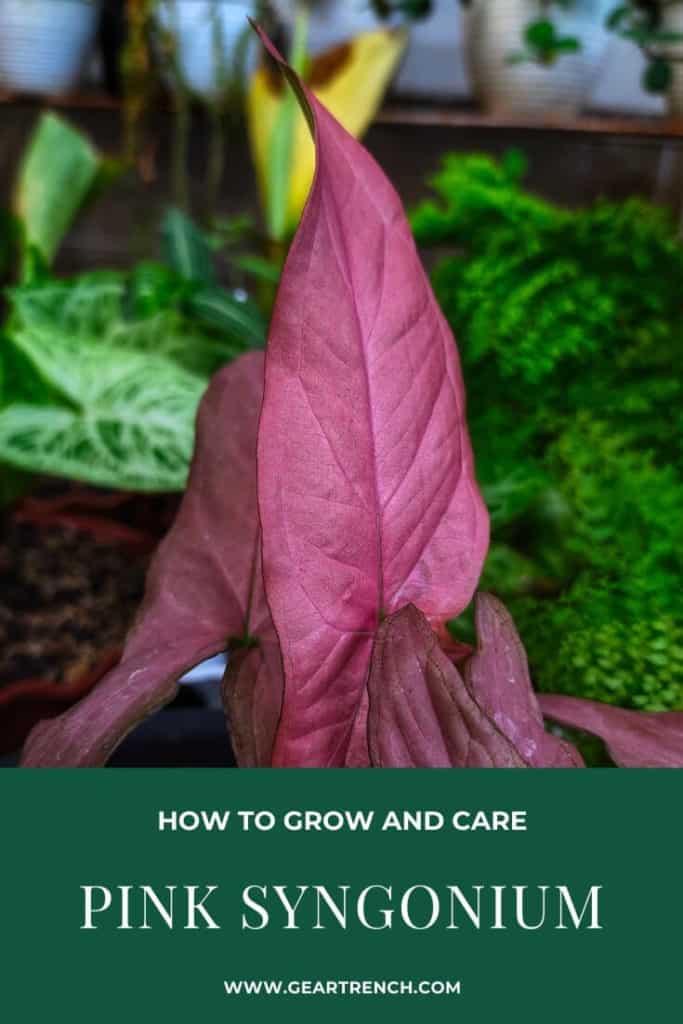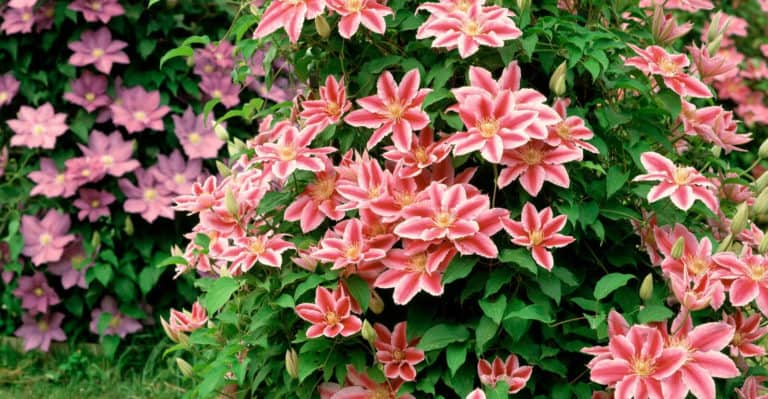Amazon has put together some great Home Gift Deals – save money and get your shopping done at the comfort of your home! Click here to see deals on Amazon
Pink Syngonium is a hardy houseplant that is grown for its beautiful foliage. Their variegated leaves look tempting to purchase as a house plant. This easy-to-grow, low-maintenance plant is a great choice for adding some color to your garden.
The plant is also known as the love vine, a vining plant with long, trailing stems that grow out from the base of its stems. This makes it so great for growing in hanging baskets and patio gardens. You can grow Syngonium in pots or large containers.
To grow and care for pink Syngonium, continue reading the article.
Some Products at Amazon to Grow Pink Syngonium
What is Pink Syngonium?
Pink Syngonium is a beautiful decorative plant member of the Araceae family and the genus Syngonium. It’s native to Mexico and Central America, where it grows in shady, moist areas and can grow up to 3 to 6 feet tall.
These are grown for their pink leaves and attractive foliage, usually green and sometimes tinged with red or purple. Syngonium is a German word that means fused ovary of a female plant, and their genus is closely related to Philodendron.
Origin: Pink Syngonium (Syngonium podophyllum) is an evergreen plant that belongs to the Araceae family. This is a genus of vining variegated plants that can grow up to 20 meters tall. However, the plant stays short with short leave without room to grow.
Appearance: It produces beautiful leaves that get more lobed with an arrow-like shape when it matures. The common name of Syngonium is attributed to the pointed leaves, giving these cultivars the name “arrowhead” plant.
Pink Syngonium is a bit rare as they have green foliage with uneven spots of pink color throughout, giving rise to its unofficial name Pink Splash.
Other names: The plant is known by different names such as Arrowhead plant, Arrowhead vine, Syngonium Pink Splash, or Goosefoot plant.
Varieties: There are many options for the different pink Syngonium varieties. Some of them include:
- Syngonium Pink Allusion: This is a smaller variety with a green base, bold gray margins, and light-green stripping. You can also transform it into a creeping, climbing shrub and use its perpetual squiggly look to fill space.
- Pink Confetti Syngonium: It has striking leaves, especially appealing to indoor plants. Known commonly for its easy care and ornamental aspect, it received its botanical name for climbing higher as it matures that you can prune to keep short.
- Syngonium Pink Spot: This plant produces brightly colored, arrow-shaped pink and green leaves with pink variegation.
- Syngonium Pink Perfection: This small plant is mostly white-green and light green, and it has pink veins that provide it with an elegant appearance. This has indeed become one of the more popular ornamental houseplants worldwide. Those searching for a red plant but would like a little less variegation can go with the Neon cultivar.

How to care for a Pink Syngonium
The Pink Syngonium is an excellent beginner’s home plant. It’s straightforward to cultivate, and its beautiful green, pinkish color leaves and air-purifying qualities make it a great addition to your home.
| Factor | Growth Condition |
|---|---|
| Soil | Moist soil mix with peat moss and perlite |
| Water | Light watering – Once a week |
| Sunlight | Medium to Low indirect light |
| Fertilizer | Balanced fertilizer once a month in the spring and summer |
| Temperature | 65°F to 85°F (16°C to 22°C) |
| USDA Zone | 10–12 |
| Common Issue | Yellowing leaves, Loss of pink variegation |
| Where to buy | Amazon, Etsy |
Soil
This plant needs loose, fast-draining acidic soil. Regular soil doesn’t work well because the plant becomes vulnerable to root rot when the water doesn’t drain properly. You can use a potting mix that includes perlite, peat moss, orchid bark, or coco coir mix.
Maintain the soil pH level on the acidic side between 5.5 and 6.5. You can add 3 part coco coir with 1 part perlite and a half-part orchid bark into the blend of soil potting mix. This potting soil mixture mimics the plant’s natural habitat that helps the plant grow healthy.
Light
The pink Syngonium requires bright light to thrive. It needs to be in an area that receives at least six hours of sunlight per day. It’s important to remember that it won’t do well in a dark room or an area with very little light. You can identify if your plant isn’t getting enough sunlight as it will have scarce foliage with blackened stems or leaves.
But also keep it away from the direct light as it needs indirect bright light. You can place the plant away from the window where it might be more exposed to direct sunlight.
Garden experts recommend locating the plant to east or north-facing windows for balanced light conditions. You can also grow it in the hanging basket or even in the bathroom, where they can tolerate high humidity.
Water
A pink Syngonium is a tropical plant that needs to be watered every two-three days. You can water it more frequently during the growing season and reduce the watering frequency in the winter.
You have to be careful not to overwater the plant as the roots don’t like sitting in the water pool. The best way to know if you need to water the plant is to check the top few inches of soil. If you insert your finger a few inches deep into the ground and feel dry, you can water it. It can also survive a few days without water.
The key is to allow the plant to dry out slightly between the watering schedule. Maintaining the right balance is vital as too much water deprives the oxygen of reaching the roots, causing root rot. Not enough water weakens the plant with wilting leaves that turns brown. Choosing a pot with a drainage hole helps drain excess water for healthy plant growth.
Temperature
Pink Syngonium’s temperature needs are between 60°F to 85°F (16°C to 22°C). Maintaining this temperature range helps the growth rate while producing vibrant colors for the entire plant.
You shouldn’t let the temperature drop to 65°F (18°C) as it could put the plant in shock and stunt its growth. In summer, try to place it away from the air conditioner or coolers, and in winter months, keep it away from the hot radiator.
Since this Arrowhead plant is a tropical plant, it likes a more temperate, warming climate with high moisture levels. You can also plant it outdoors for those living in the USDA zones 10–12 since the risk of frost is relatively low.
If the weather permits, you can place it outdoors during the summer as the extra light helps the mature plant’s leaves grow more vibrant colors.
Humidity
Pink Syngonium thrives in high humidity. They need to be placed in a room where the temperature isn’t too high or too low. The humidity level should be at least 40–50%. When planting indoors, you can increase the development of the arrowhead plant with a humidifier or related device.
If you don’t want to keep a dedicated humidifier for the plant, you can place some rock pebbles in the saucer tray and keep it watered to increase the level of humidity.
Be careful not to let the water reach the roots to prevent waterlogging. The other easy way to help maintain plants with stable humidity is by wiping the leaves a few times a week with a damp cloth. It helps clear the dust on the leaves and keep the moisture level.
Some plant enthusiasts recommend misting leaves with a spray bottle. Although it seems a convenient way to maintain humidity, letting water drench the leaves may cause fungus to develop.
Fertilizer
The best fertilizer for the Arrowhead plant contains nitrogen. It helps with the healthy growth of plant leaves. But you don’t have to fertilize it heavily as they’re light feeders. I prefer to use a liquid fertilizer that I apply every two to three weeks during the growing season of spring and summer.
You don’t have to fertilize during the winter and fall as the growth rate slows during these periods, and their nutrient requirement slows. I prefer to use this liquid fertilizer (Amazon link) that has produced the best result on my plants.
Repotting
If possible, repotting should only be done in a root-bound situation of your Arrowhead plant. If the container isn’t big enough, it will suffocate the roots as they tend to spread. When you decide to repot, use a bigger container. It helps if you water the plants 25–30 hours before repotting to help soil loose, and you can remove it without damaging delicate roots.
For most people, you will only need it to repot every few years, but it can help to use a fresh batch of soil for each growing season. You will also know if it’s time to repot when the roots begin to peek out from the drainage holes or plant has slow growth.
Pruning
Pruning this plant isn’t mandatory, but light pruning can support growth. This is done in instances of damaged or dead leaves and stems, in which case you may want to get rid of them so the rest of the plant could prosper.
Pruning also helps it to maintain a compact shape. Be careful when pruning and not apply heavy hands, as cutting off healthy areas can adversely affect growth. Since arrowhead continues to grow fast, you should be cautious when pruning the plant to prevent the overgrowth from spreading.

How to propagate Pink Syngonium
With a plant as rare and beautiful as this, it’s trendy among owners to propagate it. By cutting the stem of your Pink Syngonium, you will be able to reproduce it by following these steps:
- Before you start, ensure to sterilize all your equipment. It helps prevent any chance of infection or disease from transmitting to the plant.
- Choose a healthy plant and cut 5 inches off the stem, ensuring at least one node with some leaf present. Node is the area on the stem where roots begin to grow.
- You should have soil prepared to plant the new propagation. If you can, add the rooting hormone to the cut side of the plant to encourage growth.
- Insert the stem cutting in the soil and water it thoroughly.
- Place the new propagation where it can receive indirect sunlight. Water the plant every few days when the soil becomes dry.
- If everything goes right, the root will start to develop in a few weeks to support the new growth of this wonderful plant.
The other way you can propagate a new plant is through root cuttings in water or air layering. The air-layering process is a great way to reproduce the plant, and it’s effortless to do.
First, you need to prepare the plant for air layering. Choose a healthy stem with a couple of nodes on it. Then, you need to wrap moist moss around the nodes and secure it with a burlap wrap outside.
Keep the wrap moist by spraying water on it to provide essential nutrients. In 2–3 weeks, the roots start forming at the nodes. You can cut the node with roots and plant it in a new container for further growth.
How much does Pink Syngonium cost?
The cost of Pink Syngonium or Arrowhead plant varied depending on the quality and the level of pink variegation present. You can buy it from garden stores and online for anywhere from $30 to $150.
You can also buy it from a local seller or Facebook marketplace, where you would be able to buy it cheaply. But we make sure to check the plant is healthy and won’t lose the variegation.

What are the common pests, diseases, and other issues?
Syngonium plant is quite a pest-resistant plant and won’t get infected quickly. However, you should pay attention to any sign of pest infestation, as in larger quantities, the pest can harm the plant.
Usually, when you plant these indoors, pests come in from outside and attack the plant. However, some pests can also find ways to get on the plant itself. These include aphids and mealybugs, which suck out the sap from the leaves and stems of the plant.
This leads to stunted growth and yellowing leaves that may fall off prematurely. The best way to get rid of these pests is by using natural methods such as spraying with water, insecticidal soap, or applying a mild dish soap solution. You can use general insecticides to control the pest in a worst-case infection.
Yellowing of Pink Syngonium leaves
A yellow leaf is a sign of overwatering the plant. You should check the soil to ensure it isn’t soggy and inspect the root for any damage. You should let the soggy soil dry out before watering it again. Sometimes, it’s best to change the soil entirely and repot for proper care.
Pink Syngonium leaves turning green
The pink variegation is the reason for growing this plant, and if the leaves start to turn green, it loses its unique characteristic. If you find the leaves start turning green, it’s usually a sign that the plant isn’t getting enough indirect light.
Insufficient light forces it to get greener leaves as it produces more chlorophyll to convert light into energy. You should change the plant’s location and place it where it can receive a few hours of indirect sunlight. If you’re putting it in a basement or place where getting natural light is impossible, you can use an artificial growth light.
Pink Syngonium leaves and stem turning brown
This is another case of overwatering or overfeeding the pink variety of plants. The excess water damages the plant’s delicate roots, making it unable to supply nutrients to the rest of the plant.
This causes the leaves and stems to starve, gradually turning brown. Check your watering schedule to make sure you’re not overwatering.
Feeding too much is another reason for the plant to turn brown. The excess fertilizer can damage the plant in two ways. First, it can cause the plant to grow too fast, so the root won’t be able to keep up with the leaves and stems.
Secondly, it can cause a toxic environment for plants that turns it to be brown. As arrowheads aren’t heavy feeders, you should dilute the houseplant fertilizer to half the potency.
Pink Syngonium leaves curling
The likely cause of the plant’s dark green leaves’ curling is pests and exposure to stress. Using pesticides on the plant will help eliminate pests and restore the leaves.
You shouldn’t be continuously changing the plant location as temperature fluctuations can create stress on the plant, leaving the plant to start getting curled up.
Is Pink Syngonium toxic?
Yes, pink Syngonium is mildly toxic if you let kids or pets ingest any plant section. The toxicity is due to calcium oxalate in the plant, producing many symptoms.
As per ASPCA These symptoms may include inflammation of the cheeks and purple tongue, discomfort, mouth swelling, and blocking of the esophagus. If you see these symptoms on your child or pet, you should get them checked out by the doctor.
Conclusion
In conclusion, pink Syngonium is a beautiful and easy-to-grow plant that makes a great addition to any plant lover home. If you’re looking for a low-maintenance plant that will add some dark leafy color to your home, this is the plant for you.

Don’t forget to share this post







